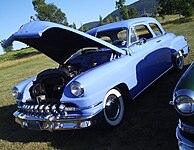DeSoto Series S-10
| Series S-10 | |
|---|---|
 | |
| Overview | |
| Manufacturer | DeSoto (Chrysler) |
| Also called | DeSoto Diplomat (export) |
| Model years | 1942–1952 |
| Assembly | Lynch Road Assembly Los Angeles (Maywood) Assembly Wyoming Road Assembly |
| Body and chassis | |
| Class | Full-size |
| Body style | 2-door coupe 4-door sedan 4-door station wagon |
| Layout | FR layout |
| Related | Chrysler Windsor Dodge Custom Dodge Coronet Plymouth Deluxe |
| Powertrain | |
| Engine | 236.7 cu in (3.9 L) Chrysler Straight-6 (1946),[1][2](1946-1950) 250.5 cu in (4.1 L) Chrysler Straight-6 (1951-1952)[2] |
| Transmission | 3-speed manual Tip-Toe Shift semi-automatic w/Fluid Drive[2] |
| Dimensions | |
| Wheelbase | 121.5 in (3,086 mm) [3] |
| Length | 205.8 in (5,227 mm) (1949) 208.3 in (5,291 mm) (1951)[2] |
| Width | 73.2 in (1,859 mm) [2] |
| Chronology | |
| Predecessor | DeSoto Six |
| Successor | DeSoto Powermaster (straight six) DeSoto Firedome (V8) |
The DeSoto Series S-10 is an automobile produced by DeSoto from 1942 through to the 1952 model year.[4] While in production, the Series S-10, which was sold with the trim package DeLuxe, was DeSoto's entry-level car, and was offered primarily as two-door and four-door sedans while the Custom offered upscale interiors and appearance including a 7-passenger sedan[2] and the extended-wheelbase Suburban sedans. The body was claimed to be "rust proofed".[5]
The DeLuxe differed from the more upmarket Custom line by virtue of the traits found in base models, namely less trim, fewer standard features, and plainer interiors in fewer color combinations. A six-tube and an eight-tube radio were optional.[6]
The Deluxe shared its engine with the Custom, and was powered by a 237 cu in (3.88 l) Chrysler Straight-6, delivering 109 bhp (81 kW) at 3600 rpm. The DeSoto had full instrumentation.[7]
Deluxes produced during the 1946, 1947, 1948 and first half of the 1949 model years used DeSoto's prewar bodies, slightly updated following the end of World War II. In 1948, low-pressure tires became standard equipment.[2] Custom models, along with Deluxe models, produced during the 1946, 1947, 1948 and first half of the 1949 model years used DeSoto's prewar bodies. A fully redesigned Custom was launched in the second half of 1949, along with a redesigned Deluxe, and these cars are referred to as “1949 Second Series” models.
In 1950, the Custom gained DeSoto's first woodie station wagon, which was not offered as a Deluxe. The Custom series also received DeSoto's first pillarless hardtop coupe called "Sportsman". Once again, the Deluxe series was excluded from this premium body style as well. Standard equipment included two-speed electric windshield wipers, a trunk light and full carpeting. In 1951, the brakes grew to 12 inches in diameter.[8][2]
The Deluxe remained DeSoto's base model until it was replaced by the DeSoto Powermaster in 1953, while Customs were unseated as DeSoto's premium model range with the introduction of the V8-powered 1952 Firedome model range of cars.

1949 DeSoto Deluxe Four-Door Sedan

1952 DeSoto Deluxe Club Coupe
DeSoto Suburban[]

The DeSoto Suburban is an automobile produced by DeSoto from 1946 through the 1954 model year. The Suburban was a continuation of DeSoto's long-wheelbase models, first introduced in 1946.
While in production, the Suburban was available under the DeSoto Deluxe, Custom and Powermaster model designations.
The Suburban differed from other DeSotos in that the four-door sedan rode a 139.5 in (3,543 mm) wheelbase, creating a car that was capable of carrying eight passengers as shipped from the factory. The car accomplished this eight-passenger capacity through the use of factory-installed jump seats, while entry was made easier with suicide doors that opened in the middle of the car. Suburbans were powered by Chrysler's inline six-cylinder engine, which delivered sufficient power to move the factory-complete car; at nearly two tons, the vehicle mated to this engine was capable of cruising speeds, but not jack-rabbit starts.
Most Suburbans were shipped with an optional rooftop luggage rack. With no station wagon in its line-up, the Suburban was at once a car for consumers who needed a large-capacity automobile, and a car almost ready-built for the taxi cab industry.
The Suburban also formed the base car for DeSoto's Custom Limousine model, an automobile seldom built on speculation, but more realistically upon customer orders. DeSoto dropped its limo build-outs at the end of the 1949 model year, finding it cheaper to sell and ship the cars to third-party vendors for customization.
Despite its popularity with taxi firms, DeSoto being the second most popular manufacturer to the industry leader Checker, Chrysler's planned 1955 restyle and the spin-off of Chrysler's Imperial into its own distinct series spelled the end of the long-wheelbase Suburban at the end of the 1954 model year.
See also[]
References[]
- ^ "Directory Index: DeSoto/1946_DeSoto/1946_DeSoto_Advance_Information_Folder". Oldcarbrochures.com. Retrieved 2011-11-08.
- ^ Jump up to: a b c d e f g h Flory Jr., J. "Kelly" (2008). American Cars, 1946-1959 Every Model Every Year. McFarland & Company, Inc. ISBN 978-0-7864-3229-5.
- ^ "1951 DeSota Foldout". Oldcarbrochures.com. Retrieved 2011-11-08.
- ^ Kimes, Beverly (1996). standard catalog of American Cars 1805–1942. Krause publications. pp. 431–441. ISBN 0-87341-478-0.
- ^ "1946 DeSoto Brochure". Oldcarbrochures.com. Retrieved 2011-11-08.
- ^ "1946 DeSoto Advance Information". Oldcarbrochures.com. Retrieved 2011-11-08.
- ^ "1947 DeSoto Owners Manual". Oldcarbrochures.com. Retrieved 2011-11-08.
- ^ "1951 DeSoto Foldout". Oldcarbrochures.com. Retrieved 2011-11-08.
- Gunnell, John, Editor (1987). The Standard Catalog of American Cars 1946-1975. Kraus Publications. ISBN 0-87341-096-3.CS1 maint: multiple names: authors list (link)
| Wikimedia Commons has media related to De Soto Deluxe Series. |
| Wikimedia Commons has media related to De Soto Custom Series. |
| Wikimedia Commons has media related to De Soto Suburban. |
- DeSoto vehicles
- Rear-wheel-drive vehicles
- Coupés
- Sedans
- Cars introduced in 1939
- 1940s cars
- 1950s cars
- Cars introduced in 1946

